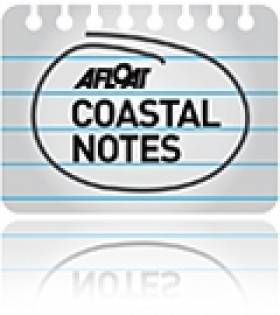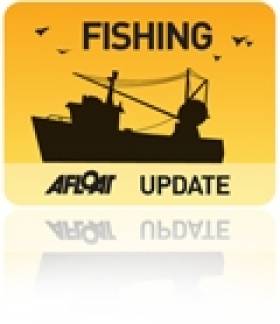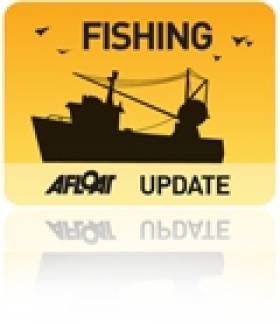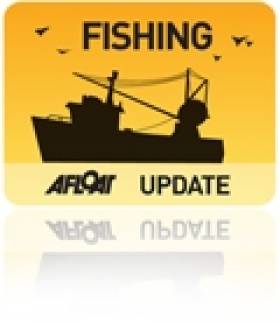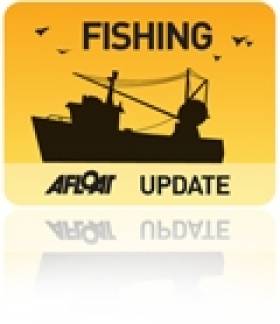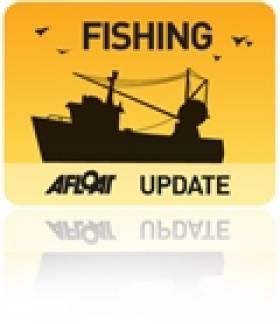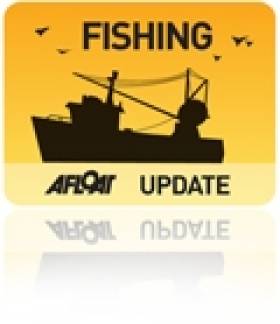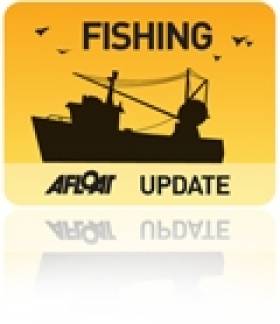Displaying items by tag: Simon Coveney
Fishermen & Scientists Meet on Long-Term Fishing Management Plan
#marineatlas – Simon Coveney, T.D., Minister for Agriculture Food and the Marine launched the Marine Institute's Atlas of Commercial Fisheries around Ireland in Dublin today (26th March '14).
The Atlas will be disseminated at a meeting of fishing industry representatives, environmental NGOs and scientists from Ireland, France, UK, Belgium, Portugal and Spain at Dublin Castle today. The meeting, part of the EU funded GEPETO project, will examine case studies on complex management issues associated with mixed fisheries in the Celtic Sea, Bay of Biscay and Iberian waters. The project aims to put in place the building blocks for integrated long-term fisheries management plans at a regional scale.
Minister Coveney welcomed the Atlas saying:
"New policy directions within the reformed Common Fisheries Policy, such as a regionalised approach and discard ban require better information. The Atlas of Commercial Fisheries presents complex data in a very visual way using informative maps, making it accessible to a whole range of stakeholders. It brings a new level of transparency in terms of fishing activities and offers new possibilities in terms of spatial management of mixed fisheries."
A new reformed CFP was agreed last May between Member States and the European Parliament. The agreement was reached after lengthy and complex negotiations under the Irish presidency, led by Minister Simon Coveney.
The Atlas of Commercial Fisheries around Ireland is the second of its kind published by the Marine Institute. It shows the distribution of fishing activities in Irish waters by gear and country. Fishing grounds as well as the distribution of landings for all the main commercial species is also shown at high resolution.
The Atlas has been developed in parallel with an online Atlas of Fisheries over a wider area within the EU funded GEPETO project. Dr. Colm Lordan, Marine Institute, co-author of the Atlas explains: "We can visualise and analyse complex scientific data and models as never before. The main challenge is to communicate the information in a way that is useful and understandable to stakeholders".
"The philosophy behind the GEPETO project is to replace the existing top-down management paradigm with a bottom-up approach in line with the new Common Fisheries Policy which is transparent, evidence based and developed in collaboration with the stakeholders. We have an opportunity to reshape the future of fisheries management and ensure a sustainable resource base and industry for future generations".
The Atlas of Commercial Fisheries around Ireland is available to download free at www.marine.ie or http://hdl.handle.net/10793/958
€23m Package for the Repair of Storm Damaged Public Piers, Harbours & Slipways (Funding List Here)
"In addition, a further €14.63m of funding is being provided for harbour development in 2014 and this represents a significant increase on the level of funding provided in 2013. This is an indication of the Government's commitment to developing our fishery harbours for the benefit of our fishing industry, seafood processing sector, other ancillary marine industries, tenants and the wider community. It is part of an ongoing and long term strategy to develop and improve the facilities at our Fishery Harbour Centres and other public harbours around our coast." (see table 3 below for details).
€11.63m of this is allocated towards safety, maintenance and new development works at six Fishery Harbour Centres at Howth, Dunmore East, Castletownbere, Dingle, Ros a Mhíl and Killybegs, in addition to infrastructural improvement works at "bull nose" pier, North Harbour, Cape Clear. This works also includes €4m for dredging works at Dunmore East.
€3m is being allocated for Local Authority Harbour Development and Marine Leisure programmes. The Department is contacting the relevant Local Authorities in relation to applications under this element of the Programme.
Flagship projects in the 2014 Capital Programme include the works at "bull nose" pier Cape Clear, major dredging works at Dunmore East, electrical upgrading in Howth, slipway works at Ros a Mhíl, Castletownbere and Dingle, and a small craft harbour in Killybegs.
The Minister commented that "the projects consisting of €23m in total capital expenditure will repair the storm damage to our vitally important fisheries piers and harbours network and will develop our harbours for the benefit of our seafood industry and the coastal communities dependent on this infrastructure. This package will help to ensure that this important infrastructure is fit for purpose in the modern era and will bring significant added value to local communities and much welcome jobs and economic activity".
Lengthy Mackerel Negotiations Lead to Agreement Between EU, Norway & the Faroe Islands
#mackerel – Following years of disagreement and often bitter dispute between the countries fishing on the annual €1billion Mackerel stock in the North East Atlantic, a three party five year agreement involving the EU, Norway and the Faroe Islands has been reached today in London. This agreement addresses the management of Mackerel by the three parties in the North East Atlantic. This Agreement was only reached after particularly intensive negotiations over the last eight weeks. Iceland is not party to this agreement.
Minister for Agriculture, Food and the Marine, Simon Coveney TD today said "I have always supported a deal that would bring an end to the irresponsible and excessive fishing of mackerel stocks that we have seen over the past five years. This new five year agreement, which is certainly not ideal, does ensure that in line with the EU and Norway, the Faroese will be subject to fixed quotas which will protect against the previous dangerously high levels of fishing and help to secure the long term sustainability of this stock, which is of vital importance to Ireland." .
The Minister also said "I welcome the fact that under this Agreement Iceland will get no access to EU Waters to fish Mackerel and this was always an important principle for myself and for the Irish Fishing industry to secure as part of any agreement in order to protect the markets for Irish fishermen. I also welcome the fact that Norway got no additional access to fish Mackerel in EU waters. In addition, I welcome the fact that the Quota of Mackerel available to Irish Fishermen to fish this year on foot of this agreement will increase by over 60% from the current 65,000 tonnes to 105,000 tonnes." Mackerel is Ireland most valuable fishery.
Minister Coveney added that "While clearly disagreeing with aspects of the deal, I always recognised the importance of bringing the Faroes Islands into an agreed and responsible management arrangement of the mackerel stock with the EU and Norway. However, I was disappointed with an aspect of the final outcome which gave the Faroe Islands an increased 12.6% share of the stock and set aside a further 15.6% for Iceland, Greenland and Russia. I consistently argued at Council and throughout these negotiations that the levels being proposed for these parties were too high and on that basis I could not support the overall deal. The European Commission and the other EU Mackerel Member States were willing to accept the granting of those levels of share to Iceland and Faroes. I am relieved that we secured agreement that Norway will proportionally share with the EU the burden of the allocation of these quota shares and this sharing of the burden was a critical requirement demanded by Ireland."
The Irish industry, represented at the negotiations by the Killybegs Fishermen's Organisation, has been fully and consistently involved in the negotiating process working closely with other impacted fishermen's organisations to influence the negotiations. Throughout the lengthy process, they have provided sound advice on the impacts of proposals and have indentified some of the key elements needed in order to protect to the greatest extent possible the interests of the Irish industry.
The parties to the agreement agreed not to participate or promote a commercial fishery for mackerel by Greenland. Greenland recently announced a new "experimental" fishery of 100,000 tonnes. Ireland fully supported the Commission in its view that such an amount could in no way be regarded as "experimental" and was in fact a new unregulated commercial fishery. The agreement opens the way to sanctions being taken against any country responsible for unsustainable fishing of mackerel outside this agreement.
Minister Coveney said "I have worked closely with Sean O Donoghue, the Irish industry representative throughout the negotiations and have at every opportunity worked to protect and advance the interests of the Irish Fishing industry in these negotiations. In line with the views of the Irish industry, I was prepared to agree to shares for both Iceland and Faeroes that would, in my opinion, have been fair and balanced. In the agreement, the parties set shares for Faroes and set aside a portion of the total catch for Iceland and others that are higher than I could support. That said, I am pleased that working closely with the Irish industry, we successfully kept large Icelandic vessels out of our waters and that the increases in shares will be borne proportionately by the EU & Norway. The agreement also set clear boundaries for any party fishing for mackerel outside of this agreement, and I consider that this is a critically important achievement. It will allow the EU to pursue through sanctions irresponsible fishing by any non contracting party.
The Minister went on to say "For the first time in five years the Irish fleet will have a greater degree of certainty and stability. The scientific indications are that this extremely valuable stock remains in good shape, and all the current projections are that this should continue. This situation together with this three party agreement should help to secure Ireland Mackerel fishing industry, which is vital to many coastal communities in Ireland. In any event, we will be working to improve Ireland position in the fishery at the conclusion of this short term deal."
The Minister concluded his remarks by thanking Commissioner Damanaki and her Commission staff for their tireless efforts to secure an agreement in difficult circumstances. "The Commissioner is a tough and able negotiator as I learned at fist hand during the Common Fishery Policy Reform process under the Irish Presidency last year. While we differ on significant aspects of this deal, I fully recognise her achievement in getting this three party agreement, which while far from ideal in some key respects, will provide some much need stability in this fishery"
#fishing – Minister Simon Coveney was guest speaker today at the 9th North Atlantic Seafood Forum in Bergen, Norway. The Minister was invited to speak to open the plenary session of the forum on the importance of seafood for global food security. The Minister was also invited to address the Global Fisheries Policy & Management seminar at the Forum on the new reformed EU Common Fisheries Policy and its impact on the seafood industry. The new Common Fisheries Policy was negotiated to conclusion by the Irish Presidency in 2013. Minister Coveney was the only EU Fisheries Minister to be invited to speak at this prestigious event.
Minster Coveney, along with BIM and representatives of the Irish seafood industry also took the opportunity to meet with a number of major Norwegian seafood companies with a view to broadening and deepening cooperation to the mutual benefit of the Norwegian and Irish seafood sectors. The Minister also had a fruitful bilateral meeting with his Norwegian counterpart where they discussed issues of common interest, including the ongoing negotiations on North East Atlantic Mackerel which is of such importance to both countries.
Minister Coveney said "I have a passionate interest in how we manage the oceans and coastal areas for the benefit of future generations and that's why I was delighted to accept the invitation to speak here today. The importance of the opportunities afforded by sustainable aquaculture and sustainable sea fisheries in contributing to global food security cannot be underestimated. Those opportunities are indeed vast and provide a huge opportunity for delivering economic growth and jobs in the seafood sector."
Coveney Blasts Iceland's 'Irresponsible' Mackerel Quota
#Fishing - Mackerel quotas will be the focus of discussions among European fisheries ministers in Brussels today as Ireland seeks a reduction of Iceland's share.
As RTÉ News reports, Marine Minister Simon Coveney will seek "strong and decisive action" against Iceland and the Faroe Islands unless the European Commission reports progress in talks over the realignment of mackerel catch limits.
Iceland's quota for mackerel increased from 2,000 tonnes in 2009 to a whopping 146,000 tonnes just two years later as stocks of the staple fish soared - partly due to migration from more southerly European waters.
But Minister Coveney has blasted Iceland's move as "irresponsible and unacceptable fishing".
The talks come in the wake of fruitful reform of the Common Fisheries Policy led by the minister as president of the EU Fisheries Council during Ireland's EU Presidency in the first half of this year.
CFP Reform Reaches Final Hurdle In Brussels
#CFP - RTÉ News reports that the "final battle" before reform of the Common Fisheries Policy (CFP) comes up today as a European Parliament committee votes on the changes led by the Irish Presidency of the EU in the first half of this year.
As previously reported on Afloat.ie, Europe's fisheries ministers agreed in May to a new policy that sets quotas based on scientific advice, with the aim of achieving healthy fish stocks and ultimately higher quotas as stocks are managed sustainably.
The reforms were pushed by Marine Minister Simon Coveney during his presidency of the EU Fisheries Council. The minister also made as his priority the ending of the practice of fish discards, a subject of much public outcry following revelations that as much as 50% of the catch in the North Sea is thrown back dead in the water.
Meanwhile, Ireland's additional quotas under the Hague Preferences have also been retained, a move that comes as some relief to the Irish fishing industry - which will also benefit from CFP amendments that would support the renewal of older fishing fleets.
However, conservation groups fear that these proposals would see the EU's fishing fleets grow to a size that far exceeds the available fisheries resource in European waters.
Irish Presidency Reforms EU Fisheries Policy
#fisheries – This morning the Irish Presidency delivered on one of its highest priorities as it secured agreement on the EU's new Common Fisheries Policy. Minister Coveney, in welcoming the agreement stated that "At the very beginning of Ireland's Presidency I set out an ambitious and demanding work programme, as I believed it was imperative that reform of our fisheries had to happen now. Having led months of intensive negotiations, I am delighted that we have now agreed on a policy which is practical, implementable and one which places sustainability firmly at its core. It is a policy which will provide for a vital, vibrant industry and healthy fishing stock long into the future".
The main achievements under the new Common Fisheries Policy will be as follows:
With the new policy we have to set quotas that fully respect scientific advice. This will lead to healthy fish stocks and higher quotas as fish stocks are managed at maximum sustainable yield levels. From an Irish perspective the so called "Hague Preferences" have been protected which give additional quotas to Ireland each year for critical traditional stocks around our coast such as cod, haddock and whiting.
Discarding of fish stocks will no longer be allowed. This ends the old policy which forced fishermen to waste food by discarding fish at sea. The new policy will result in higher quotas for our fishermen.
The new policy puts fishermen at the core of developing technical and conservation measures to protect juvenile fish and vulnerable fish species with a completely new regionalised decision making approach. This is a big change as up to now decision making was centralised in Brussels.
A commitment to develop and strengthen biologically sensitive areas, with spawning grounds and high populations of juvenile fish. This will protect and allow for
additional protections for the sensitive fishing grounds off the south and west coast of Ireland known as the "Irish Box".
Retains ownership of fish quotas as a public asset and removes the threat of privatisation of quotas and their concentration in large foreign companies. This will protect the family owned fishing vessels around our coast.
On ending discarding, Minister Coveney said "this complex element has been one of the most contentious and difficult to agree given the many different perspectives on how such a ban would work in practice. What we have agreed this morning is to deliver a new fishing policy which strives to help restore our fish stocks and protect the fishermen and communities which depend on fishing for their livelihoods."
The reform, when taken as a whole, delivers on not just a discards ban but also provides the means for new ways of sustainable fishing, a more transparent and competitive market, as well as empowering fishermen by giving them a central role in decision making for their fisheries.
The agreement was reached between the Irish Presidency, European Parliament and the European Commission and will now go to the Committee of Permanent Representatives for final approval.
#FishFarm - The Galway Bay fish farm debate rolls on as Ireland's Marine Minister says there will be no damage to the environment or wild fish stocks.
Simon Coveney was speaking to Galway Bay FM last week on Bord Iascaigh Mhara's (BIM) proposals for a deep sea salmon farm off the Aran Islands.
The 500-hectare scheme would be the largest of its kind in Europe and has the potential to create hundreds of jobs in the region. A decision on BIM's licence application for the development is set to be made in the coming months.
But the plans have been opposed by conservationists, local anglers and the even the State fisheries body.
Last Wednesday 22 May, Inland Fisheries Ireland (IFI) published an FAQ on its concerns regarding the Galway Bay fish farm proposal, its own submission regarding the environmental impact statements attached to the licence application, and its reasons for avoiding a public debate on the issue.
"IFI is satisfied that its submission, which is supported by international scientific studies, clearly sets out its concerns and recommended measures for mitigation," it says.
Fish Discards Should End 'Within Six Years' Says Coveney
#CFP - The deal reached between EU fisheries ministers this morning on reform of the Common Fisheries Policy (CFP) should bring an end to the practice of fish discards within the next six years, according to Ireland's Marine Minister.
As reported earlier today on Afloat.ie, Minister Simon Coveney emerged from 36 hours of talks in Brussels confident that a far-reaching reform on fisheries policy had been reached.
RTÉ News reports that the compromise deal will see a 93% ban on discards take immediate effect, phasing towards a full ban by 2019, with special allowances made in certain cases where sustainability of fish stocks allows.
Minister Coveney, as president of the EU Council of Fisheries Ministers during Ireland's EU presidency, will submit the agreed reforms to the European Parliament - which has previously been steadfast in its demands for a complete ban on fish discards to halt the depletion of fish stocks in European waters.
As previously reported on Afloat.ie, this week's discussions on fisheries reform in Brussels have been described as a "once-in-a-decade opportunity" to end the wasteful practice of fish discards, which has seen as much as 50% of the catch in the North Sea is thrown back overboard dead.
#Fishing - Marine Minister Simon Coveney will present a revised comprehensive compromise Irish EU presidency text to the EU Council of Fisheries Ministers on Monday 13 May seeking a new mandate to re-enter final negotiations with the European Parliament on a reformed Common Fisheries Policy (CFP).
Minister Coveney said that these decisive negotiations for agreeing a comprehensive reform of the CFP in Brussels on 13-14 May are likely to be very difficult given the significance for the next decade of what may be decided at the meeting.
“An enormous amount of work has gone into progressing the reform with council, commission and parliament during the Irish presidency," he said. "We now have an Irish presidency substantially revised set of compromise proposals which I believe give us a sound basis for positive engagement at council.
"Agreement at council on this presidency compromise package would support an ambitious reformed CFP which would secure a better future for our fish stocks and for the fishermen and coastal communities who depend on them."
The minister emphasised that there is a "very short window of opportunity for council and parliament to agree and deliver an effective reform of our fisheries policy and the Irish presidency is doing all it can to bring the institutions together to take this historic opportunity.
"I believe that if all parties focus on the critical elements of a reformed CFP, we can by working together reach realistic and substantial agreement through the co-decision process during the Irish presidency.”
Formal negotiations with the European Parliament have resulted in the Irish presidency drawing up a revised compromise 200-page legal text, which Minister Coveney, as president of the council, will use as the basis of negotiations with EU fisheries ministers.
The objective is to get political agreement on a final compromise package to enable conclusion of negotiations with the parliament and the commission on CFP reform during the Irish presidency, which concludes at the end of June.
Minister Coveney will also update EU ministerial colleagues on progress made to date by the Irish presidency during the ‘trilogue’ process where EU presidency (council), commission and parliament have been engaged in complex discussions on refining proposals for CFP reform.






























